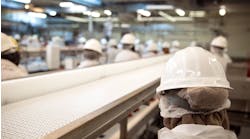Listeria is a very common bacterium that adapts well in many environments. It is found in soil, water, animal guts and on raw foods, and can easily be introduced into and spread throughout food production facilities.
Listeria can form biofilms that help them attach to the surface of floor, drains and equipment – making them more difficult to remove during cleaning, and protecting them from drought, heat and standard cleaning and disinfection chemicals. Listeria biofilm is often the source of food product cross contamination.
Additionally, Listeria can grow in cold environments and can survive freezing temperatures. These conditions are often used to control microbial growth, but for Listeria they serve only to restrict the growth of competitors. This means that refrigerated and frozen foods still are at risk. Most ready-to-eat food processing environments are chilled and provide the nutrients and moisture required for Listeria growth. So, there’s good reason for being concerned about Listeria contamination if you produce ready-to-eat, chilled food.
Floors
Floors that are made of inappropriate materials or that have been installed poorly can lead to static water pools, water trap points or water absorption. Badly constructed or poorly sealed wall-to-floor or drain-to-floor joints often lead to water becoming trapped, as can poorly maintained and damaged floors with cracks, holes or gaps. All these situations can lead to Listeria colonization. Consequently, the appropriate selection, installation and maintenance of your production floor are very important with regard to Listeria control.
Proper cleaning and sanitation are vital to food plant operations, but as with many operational aspects, competing concerns must be balanced. Read this report to discover how new chemicals and application systems can help food processors find the right balance. Download the Special Report
Drains
If Listeria is present in your food production facility, it will most likely be found in your drains. The reason for this is that drains act as collection points for most of the Listeria-contaminated water on site, and then provide the nutrients and moisture required for the Listeria to grow.
Even though cleaning drains is an unpleasant and complex task, it is critical for Listeria control. Dirty drains can be a source of Listeria contamination, and flooded drains can spread listeria via pools of contaminated water on the floor. Drains should (if possible) only be cleaned during production downtime, and you’ll need to give aerosols time to settle before rinsing and disinfecting your food contact surfaces.
Select, install and maintain your drainage systems to eliminate the chances of standing water and water backups. Hygienically designed drainage systems are much easier to clean and maintain, and they minimize the risk of microbial growth.
How to avoid Listeria contamination from floors and drains
Listeria can be transferred from contaminated floors and drains to other food production areas – and to food itself – in several ways. These include footwear, equipment and trolley wheels, as well as cleaning equipment. The best way to avoid Listeria contamination from your floors and drains is to clean and disinfect them regularly. Remember to clean floor and drains in a way that minimizes contamination of other surfaces in the room. The use of high-pressure hoses or mechanical scrubbing will increase the risk of Listeria aerosolization, where the bacteria spread through the air into other areas and onto equipment, food, and food contact surfaces. Instead, use dedicated color-coded manual cleaning tools for floor and drain cleaning. Tools used to clean floors should have a different color from those used to clean drains and from those used to clean food contact surfaces.
Processing equipment
Like floors and drains, hard-to-clean areas on and inside food processing equipment can allow for water accumulation and contamination, which can then lead to Listeria colonization and growth.
To minimize the risk, it’s essential to use hygienically designed processing equipment, which is easy to clean and made of suitable food contact-compliant materials. The frequency of cleaning and disinfection should be based on risk assessment, but for equipment used to process chilled ready-to-eat foods, it should probably be at least once a day.
Daily cleaning should be supplemented with regular equipment stripdowns and deep cleaning to ensure that areas that are difficult to reach during daily cleaning are controlled. Again, the frequency of deep cleaning should be based on risk assessment.
During cleaning and disinfection, pay attention to hard-to-reach areas on the equipment. These are the areas where Listeria might be present, especially if an area is wet. These areas can include poorly drained open equipment frameworks, niches, hollow unsealed rollers, poor welds, spaces inside slicing machines, and areas under covers and guards.
Equipment lubricants and moisture traps on compressed air lines also can become a source of Listeria contamination, and should be changed and checked regularly to minimize this risk.
Cleaning equipment
Cleaning equipment can be a major source of Listeria contamination – with surveys showing that up to 47 percent of cleaning equipment in food-processing areas test positive for Listeria (Campden BRI, 1990).
To prevent Listeria contamination, there are two important factors to consider for your cleaning equipment: hygienic design and proper maintenance.
Your cleaning equipment should be of appropriate hygienic design to facilitate easy cleaning and prevent microbial growth. Hygienic design features include smooth surfaces, one-piece construction, easy dismantling, and a lack of crevices and coatings.
In addition to using hygienically designed tools, it is very important to maintain your cleaning equipment properly. All tools should be replaced, cleaned and/or disinfected regularly after use and stored correctly on suitable wall brackets or shadow boards. It is also essential to use color-coded tools, and to segregate tools used to clean floors from those used for food contact surface cleaning.
Chillers, freezers and air-handling systems
As mentioned above, Listeria can survive at very low temperatures – even as low as -5 °C. Chillers and freezers are cold and wet, and Listeria faces less competition from other microorganisms in these environments, making them perfect Listeria hideouts. It is essential to keep the evaporation plates and fans in chillers and freezers clean and disinfected at all times. Condensation from cooling systems should be directed to the drains or to drip pans, which should be emptied, cleaned, and disinfected regularly. Never allow products to pass underneath a cooling or freezing system. In many air-handling systems, there are also evaporators that need to be cleaned. Moreover, it is critical to prevent condensation – and subsequent water buildup – in your air-handling systems.
Editor's Note: This article was sponsored by Remco Products


